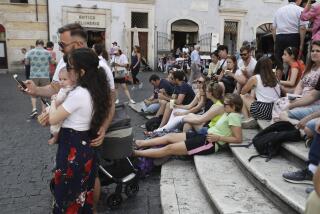This pandemic traveler made it to Europe, the pyramids and mom
- Share via
Janet Moore of Long Beach has been in the travel business for years, organizing cultural trips through Distant Horizons, often for university and museum groups. But in August, Moore found herself on the consumer end of the trade, trying to visit her mother during the pandemic and hoping for a glimpse of the way forward for her industry.
Moore’s mother, 86, lives in Spain and usually visits Moore in Long Beach every summer. This year she was quarantined instead and feeling isolated, having recently moved from Madrid to Málaga.
“This is really hard on older people living alone,” said Moore.
So Moore started planning a trip, which taught her several lessons about the world of travel now.
At the time, Moore knew that California and U.S. health officials were discouraging nonessential travel (they still are). Moore also knew that Spain had tight restrictions on travelers arriving from the U.S.
But Moore had a strategy. She decided to take COVID-19 tests and fly elsewhere first.
Where? Turkey, Egypt and Serbia. All had lower COVID rates than the U.S. All were willing to receive travelers from the U.S. (although one did require a negative COVID test). And none posed problems for a traveler on her way to Spain.
Get inspired to get away.
Explore California, the West and beyond with the weekly Escapes newsletter.
You may occasionally receive promotional content from the Los Angeles Times.
She paid for it all with miles. Besides seeing her mom, “I really did want to see what it would be like to travel right now,” Moore said. “There’s nobody really traveling as a tourist.”
On Aug. 15, Moore flew to Turkey by way of Munich, Germany, the first of 14 flight segments in about as many days. Before leaving, she’d taken a COVID test in Long Beach so she could present its negative result as she entered Egypt.
At every step, Moore said, she filled out all required paperwork and told the full truth about where she had been and where she was going. (Anybody considering travel abroad needs to look closely at web pages of the U.S. State Department and their intended destinations. Rules are changing often.)
Here are six things Moore learned.
1. Not everybody is arguing about masks
Moore, who rides a bike regularly between her Long Beach home and nearby office, has written letters to City Hall complaining about how few masks she sees. Through this four-country trip, “I never saw or encountered anybody refusing to wear a mask,” she said. In restaurants, hotels, museums and other public settings, “there were announcements everywhere that you had to wear a mask while not eating.”
2. The pyramids are lonely
In Egypt, there were no cruises on the Nile between Aswan and Luxor. But so long as Moore had her temperature taken first, many of Cairo’s museums and restaurants were open. And when she reached the pyramids at Giza about 9 a.m. one day, they were all but empty.
In normal times, Giza is some of the most heavily trodden ground in northern Africa. But on this morning “I was the only human being in the entire pyramid complex except for security and the guys with the camels. No other tourists.”
Similarly, at the Cairo Egyptian Museum, room after room was empty. “The only place where I saw some people was the Tutankhamen room,” she said.
3. In flight, the first shall come last
Many international airlines, including Lufthansa, Egyptair, Turkish Airlines and Iberia, are now boarding plane passengers from the back row forward, which aids in social distancing but is a reversal of the tradition (still common in the U.S.) under which first-class passengers board first. “Every airline I took on this trip did it like that. If you were in first class, you had to board at the end,” Moore said.
Another thing about those planes? They tend to leave on time and arrive a little early. “Everything is faster because there’s less demand on services,” Moore said. “I don’t think I saw a flight that was more than 60% full. The flight from L.A. to Munich was probably 15-20% full.”
Still, Moore traveled light. Egyptair and Turkish airlines said on their websites they didn’t want people using overhead luggage space, and they tightened their usual limits on hand luggage. So Moore traveled with a single piece of luggage that would fit under a seat. As it turned out, neither carrier enforced the rule.
Another lesson she learned as she roamed terminals between flights: “You cannot buy newspapers at airports anymore.”
4. New hotel standards are circling the world
In European hotels, as in many U.S. hotels now, check-in desks feature plexiglass screens, and the usual policy is that housekeepers don’t service your room until after you’ve spent at least two nights there, Moore said. Many guest rooms have disposable plastic cups instead of glass, with no magazines or brochures.
Also, elevator limits are common. At the Marriott Mena House Hotel in Cairo, elevators were limited to two guests at a time. All dining was outdoors. Some hotels banned indoor dining; others allowed it.
5. In ancient places, new habits prevail
The Old City of Istanbul goes back many centuries. But modern precautions have taken hold, Moore said. Before she entered mosques there, her temperature was taken. Inside, marks on the floor indicated where worshipers and visitors could stand or kneel to remain safely distant.
Also, many Europeans are known for keeping late hours, but the pandemic has changed that. In Spain, Reuters reported in August, bars and restaurants were required to close by 1 a.m. In Serbia’s Belgrade and Novi Sad, Moore found that pandemic rules required that indoor dining stop at 9 p.m., outdoor dining at 11 p.m.
For anyone familiar with Belgrade, Moore said, “it was very strange to see Republic Square empty after 11.”
6. Sometimes you do more than the minimum
The trip’s last leg — the visit with her mother — began with a flight from Belgrade to Frankfurt, Germany, then on to Málaga. But before leaving Serbia, Moore took another COVID test (about $60; results in less than 24 hours).
“It wasn’t a requirement, but I kind of couldn’t believe it wasn’t,” Moore said. “So I did it for myself and my mother, because I wanted to make sure I didn’t have it.”
United is doing the same from SFO. Hawaii eases quarantine rules Oct. 15
She spent three days with mum, who she said is now happier and healthy.
Since then, Spain has suffered a surge of COVID cases and stiffened its pandemic restrictions. The U.S. Embassy in Spain warns that American citizens “cannot enter Spain unless they meet very specific requirements or have already obtained special permission from the Government of Spain.”
By the end of August, Moore was back in California. Four days after her return, Moore said, she took another COVID test: negative again.
“The travel industry is doing what they can, “ Moore said. “People are very conscious of doing all they can to mitigate the chances of transmission.” Despite the horrors of the pandemic, Moore said, she’s expecting “wonderful” opportunities for seasoned, careful travelers in the year ahead.
More to Read
Sign up for The Wild
We’ll help you find the best places to hike, bike and run, as well as the perfect silent spots for meditation and yoga.
You may occasionally receive promotional content from the Los Angeles Times.







